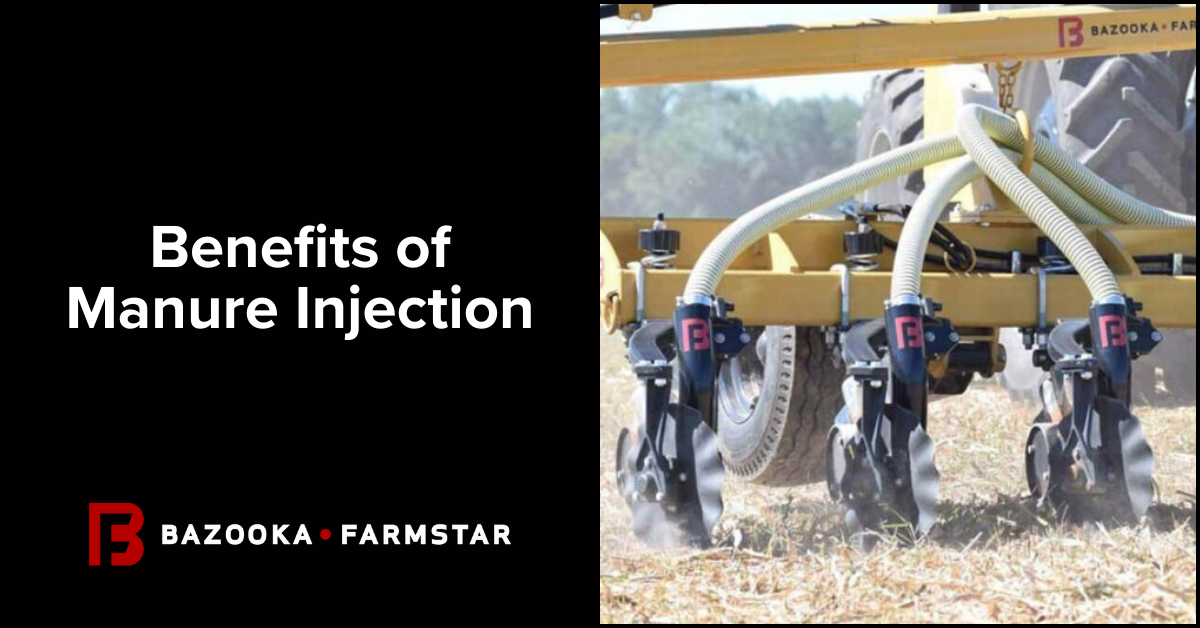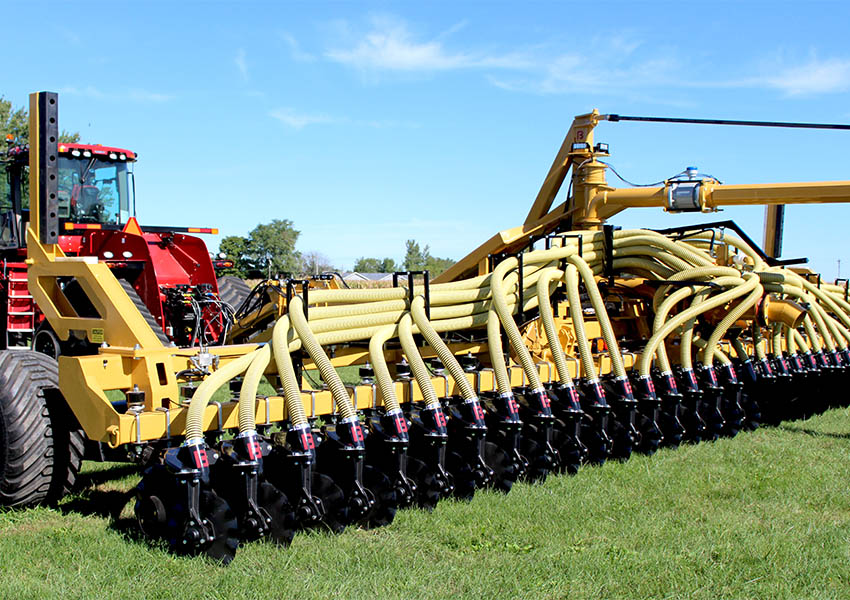Manure Injection: Maximizing Nutrient Efficiency and Minimizing Environmental Impact
November 7, 2023

Manure injection can seem like an expensive venture to pursue, especially if your state doesn’t have rigid regulations around injection or incorporation. But the benefits of injecting manure into a field, when compared to surface application, are clear—and they include financial, nutrient, and environmental advantages.
Benefits of Manure Injection
Applicators and farmers alike need to seek more responsible means of manure management. Manure injection reaps many proven benefits including odor and nutrient loss reduction—two shortcomings of surface application.
Even if your area doesn’t have strict mandates for manure odor or runoff, you can see the direct benefits of manure injection to your operation, your crops, and your bottom line.
PRO-TIP: We suggest getting ahead of the mandates.
Let’s look in-depth at the main benefits of manure injection.
Manure Injection Keeps Nutrients in the Soil
First and foremost, manure injection helps to minimize the loss of nutrients. When manure is surface applied, a significant amount of its valuable nutrients can be lost due to runoff or evaporation. However, with manure injection, these nutrients go directly into the soil and “stick,” reducing the risk of them being washed away or wasted.
For Dan Andersen, Associate Professor of Manure Management and Water Quality at Iowa State University (ISU), nitrogen is the nutrient of focus. “If you’re surface applying, you are throwing away about 15% of the nitrogen that you put on,” he said. “If you inject, you’re capturing basically 99% to 100% of the nitrogen you’re putting down.”
He continued, “Injection also reduces ammonia loss in the gas form as well as washing of the manure nutrients like nitrogen with a runoff event that might occur.”
In addition to short-term nutrient benefits, manure injection can improve soil health and fertility in the long run. As the nutrients from the manure break down and become incorporated into the soil, they promote the growth of beneficial microorganisms and enhance overall soil structure. This means healthier plants, improved water infiltration, and reduced erosion.
Data from other areas of the country show the same conclusion. Over six years of trials at Ohio State University Extension, applying incorporated swine manure yielded an average of 17.4 bushels per acre more than 28% UAN, the common commercial fertilizer.
Nutrient capture is one of the biggest benefits of injecting manure, but there are other benefits as well.
Manure Injection—AKA No-till Manure Incorporation
Manure injection is also called no-till application because you don’t have to do a till pass after injection like you do (or, at least, should) after surface application to incorporate the manure into the soil.
“If you’re surface applying, hopefully you’re following that up with a tillage pass,” said Andersen. “So why not do it all at once rather than have to do two field activities?”
Tilling after surface application is to incorporate the manure and accomplish what injection does all at once—trying to get the nutrients into the soil and get them covered into contact with soil to prevent nutrient loss.
Injecting also provides more control over what soil gets worked. “If you do a surface application, then come back and do a tillage pass, that pass is pretty indiscriminate, right?” said Andersen. “You’re trying to work the soil all over to incorporate the surface-applied manure. Whereas if you do an injection pass, you can really think about things like strip till or zone tillage—right where the nutrients are placed rather than disturbing the whole soil profile.”
Injection manure application saves time in the field and reduces the number of field activities, among its many other benefits.
Manure Injection Protects Water Quality
Bazooka Farmstar is headquartered in Iowa, so we’re familiar with our state’s mandates and those in the Midwest states around us. Iowa has strict requirements for preventing fertilizer runoff into water supplies. While we won’t get into the details of the regulation here, we will say that injection application is the optimal way to meet those requirements.
For manure, phosphorus is a main concern when it comes to water quality. Ammonia and nitrogen are, too, but we discussed those above and they follow the same pattern as phosphorus when comparing surface application to manure injection.
Andersen said, “The research that we have here in Iowa suggests a 70% to 85% reduction in phosphorus movement just by switching from surface application to injection.”
While other states haven’t passed water quality regulations as strong as those in Iowa yet, they may be coming. We recommend getting ahead of the regulations and switching to manure injection sooner rather than later. You can see the benefits for water quality but also for your own farm or custom applicator business.
Manure Injection Reduces Odor
By injecting the manure beneath the soil surface, the strong smells associated with manure application can be significantly reduced. This can be a game-changer for those living in a farm’s proximity as well as for those working on the farm.
Why Farmers Don’t Opt for Manure Injection
The main reasons we hear farmers and custom applicators hesitate to switch to manure injection include:
- Cost of equipment
- Slower application
Those are the usual suspects. Let’s look at each.
We can’t deny it—the cost of manure injection equipment can be a burden to getting started. But read on to the next few sections to see how, in addition to the benefits mentioned above, there are cost-saving outcomes and quick, affordable ways to get started.
As for slower application, that is what it is—slow and steady wins the race, they say. For farmers doing their own application, the slowdown isn’t a huge deal. But for custom applicators, time is of the essence during pumping season.
Why is manure injection slower than surface application? Andersen says, “If you’re injecting, it takes more horsepower to pull that machine, and you have to go a little slower. It takes a higher horsepower tractor to do it because you’re still pulling that hose or a tank wagon, and we now have to have a little more horsepower to pull the injectors.”
However, a slowdown in application can lead to less time in the field overall. Andersen says, “For the most part, if you’d be doing a follow-up tillage, it saves you time doing it all in one pass compared to two different steps. We use injection as our tillage event, and it works great for us.”
So while there are a couple of downsides to starting manure injection, the benefits pretty clearly outweigh them.
Cost Savings from Manure Injection
Now, let’s talk money.
It can be expensive to switch from surface application to manure injection.
But, Andersen pointed out, “When you look at how much nitrogen you’re saving, there are opportunities to get to payback.”
He did the math for us. “I’d estimate that going to injections instead of surface applications adds maybe an extra $.005 per gallon of cost. But when you compare that to the amount of nitrogen you’re saving, it only takes three or four years to pay for the toolbar.”
When Andersen did some testing on his own research field, he estimates he saved about $19/acre in fertilizer value by doing manure injection. This number is based on 2015 prices, but the effect is still the same, so he says the savings are likely even higher with today’s fertilizer costs.
Studies have continued to show that manure injection helps meet the nutritional needs of crops while reducing environmental impact.
Transitioning to Manure Injection
At Bazooka Farmstar, we offer various levels of dragline and tank options for manure injection.
For dragline operations, we offer a range of injection toolbars, which include the Titan 1 and 2 toolbars, various standard toolbars, and the Dietrich 3-point toolbar. We offer a variety of pull types and 3-points as well as unit spacing options so you can find the configuration that’s right for you.
For tank operations, we have our tank bars, including our standard rigid tank bar as well as our Quick Attach Phantom tank bar. Both are great options for getting started with manure injection within your existing tank setup.
Finally, we have our Phantom Series (which Andersen said he uses and is very happy with). The Phantom 1 and 2 Injection Units provide maximum manure injection performance with minimal soil disturbance. Read all about the new Phantom 2, just launched this year.

The Results Are Clear
Farmers and custom applicators should look at starting or expanding manure injection operations to:
- Optimize nutrient use from manure application
- Reduce field activities with no-till injection
- Protect local water quality
- Reduce odor from manure application
- And more
We encourage you to look at manure injection, even if mandates haven’t made their way to your region yet.
When you’re ready, request a quote to see how Bazooka Farmstar equipment can have you on your way to high-nutrient soil, less till time, and meeting current and future mandates. Not ready for a quote? Contact us or contact your dealer to discuss manure injection for your operation.
